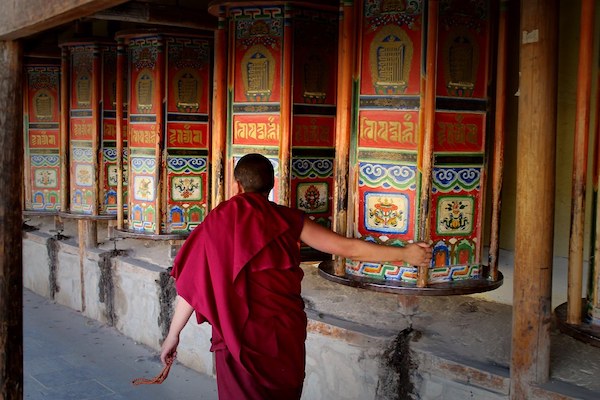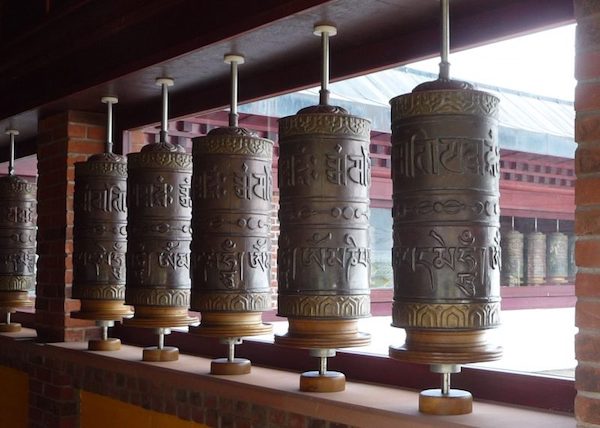
One of the most widely recognized symbols of Buddhism today is the spinning prayer wheel native to Tibetan Buddhism.
The concept came from Buddha’s teaching method of “turning the wheel of dharma” (which in Buddhism, means law and order in the universe, hugely important to a person of this faith). The first prayer wheels were made over 1500 years ago at a time when not many people could read. Repeating even the most important mantra – “Om Mani Padme Hum” – wasn’t possible for lay practitioners unless they spent time studying, and studying meant being able to read.

“Monk spinning prayer wheel” by EMUCrossCultural is licensed under CC BY-NC-SA 2.0 Creative Commons
For this reason, mantras were usually written around a prayer wheel, and it was believed that when a person spun the wheel, it had the same effect as reading the mantra. It allowed for a simple and elegant way of taking mantra repetition to a new level by giving the practitioner a way to break mental restlessness. To spin it was to generate spiritual merit.

Over 2,500 years ago in the Himalaya of Tibet, the same monks who practiced Buddhism kept small canine companions who watched over the monasteries and kept them warm at night. A genealogical tree of Tibetan dogs created by Professor Ludvic von Schulmuth suggests that these little dogs we know today as the Tibetan Spaniel evolved from a descendent of the Gobi Desert Kitchen Midden Dog some 10,000 years ago. They became inexorably connected to the Buddhist monks and lamas who bred them, and though the legend is doubted by some, it has been passed along as common knowledge that “Tibbies” were trained to turn the prayer wheels in many monasteries.
Susan Waller Miccio shares the legend about a Tibbie named “Senge” whose people were overcome with a terrible sickness. Senge did what he could for his friends, but he was a mere little dog and despite his efforts, the people did not get better. Senge despaired, and as he passed the great prayer wheels, he thought, ‘If only I had hands, I could spin the wheels” and my prayers would be heard. But Senge had no hands—only paws, and his friends still suffered. We won’t spoil the story which you can – and should – read here (it’s delightful), but the legend of the breed known as the “Prayer Dog” of Tibet finds its modern-day expression in the tradition among Tibbie people of wishing one another well with the saying, “The Tibbies are spinning prayer wheels for you.”
Image: Tibetan Spaniel by Bob Smerecki is available as fine art and in home decor and lifestyle items here.
